Guitar basics – a beginner's guide to the guitar and guitar playing.
On this page, you'll find everything you need to know about playing the guitar, including: the differences between electric, acoustic, classical and bass guitars; guitar playing styles; tuning a guitar; playing chords; reading guitar music; and much more...
If you have questions on any aspects of guitar playing, then feel free to ask them in the comments section below!
Subjects covered in this guide:
(Click on a title to jump to the relevant section of the page.)
Information on the different types of guitar, and which one you should choose.
If you're left handed, buying a left-handed guitar may not always be the best choice. Find out why in this section.
A guitar's strings need to be tuned. Tuning a guitar can be a little tricky at first, but will soon become second nature.
Modern guitar styles typically involve a mixture of chord and melody playing. In this section, you'll learn the basics of making notes on your guitar.
Most electric guitarists use a pick (also known as a plectrum) to strum or pick the strings. On acoustic guitar, the choice between pick and fingers is not as clear-cut.
In this section, you'll find out how acoustic, classical and electric guitar styles vary.
Playing rhythm guitar with chords is the "bread and butter" of a guitar player's role. In this part of our guitar basics guide, you'll find a brief lesson on playing chords.
Many guitarists learn songs and riffs, etc., by ear, but it can be highly beneficial to learn to read guitar tab or traditional music notation.
Guitar Basics - Types Of Guitars
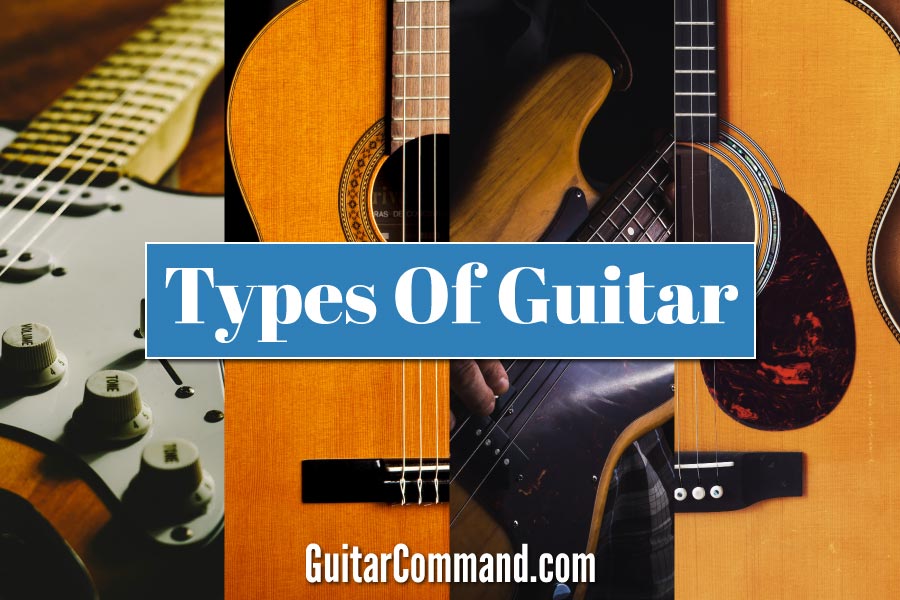
- You can find more information on the different types of guitars on this page: Types of Guitars
There are four main types of guitar (click on the links to go to the relevant part of the page):
Acoustic vs Electric vs Classical vs Bass Guitar
Acoustic and electric guitars are tuned in the same way, and the notes of their fretboards are the same. Therefore, the chords and scales you learn on one can be played on the other.
Many guitarists swap between acoustic and electric guitars, but some playing styles are more suited to one than the other.
You can find out more about the differences between these guitars on this page: Electric Vs Acoustic Guitar
Although a classical guitar is tuned the same way as an electric or acoustic guitar, it is generally played with the fingers (rather than with a pick) with a specialised technique. However, all the notes are the same and many electric / acoustic guitarists also play classical (and vice versa).
You can find out more about classical guitar playing on this page: Learning Classical Guitar
The bass guitar is slightly different than other guitars, having only four strings. The strings of a bass are tuned the same as the lowest four strings of guitar, only an octave lower.
You can read our complete beginner's guide to playing bass guitar on this page: Playing Bass Guitar
Whereas there is some overlap between bass and other guitars, bassists tend to specialise in bass guitar playing, learning techniques specific to the instrument.
Let's learn more about each of the main types of guitar...
Acoustic Guitar / Steel-String Guitar
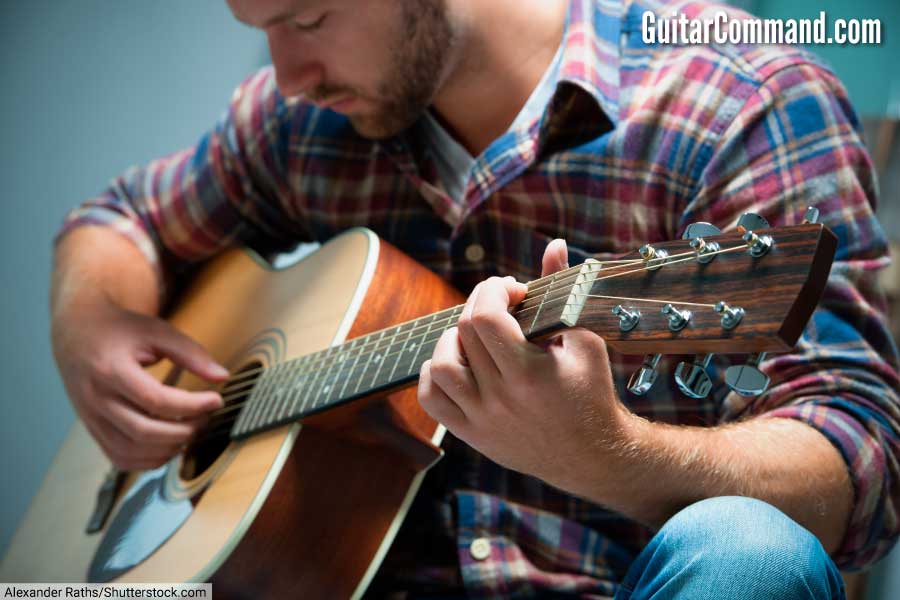
Acoustic guitars have steel (or equivalent) strings, and for this reason are also known as "steel-string" guitars. They have a bright, metallic sound and can be played with a pick or with the fingers.
These versatile instruments are used in nearly all styles of modern music, but are most common in folk, folk-rock and traditional styles.
Electro-Acoustic Guitar
A pickup is a device that converts the vibrations of a guitar string into an electrical signal that can be amplified.
Acoustic guitars fitted with pickups are known as electro-acoustic guitars. They can amplified just like electric guitars, and are usually used with specially-designed acoustic guitar amplifiers.
An electro-acoustic guitar is not an alternative to an electric guitar; its neck is wider and has fewer frets, and its sound is completely different. Electro-acoustic guitars are also prone to feedback if turned up loud.
If you see a solo singer / songwriter strumming chords while singing, he or she will probably be using an acoustic guitar.
Twelve String Guitar
Some acoustic (and electric) guitars have twelve strings rather than the usual six. Twelve-string guitars produce a loud, thick sound, and are typically used for providing rhythmic accompaniment for singers or instrumentalists.
Twelve-string guitars can be tricky to play, and their uses are somewhat limited. As a beginner, you'll almost certainly be better off getting a standard 6-string guitar.
Electric Guitar
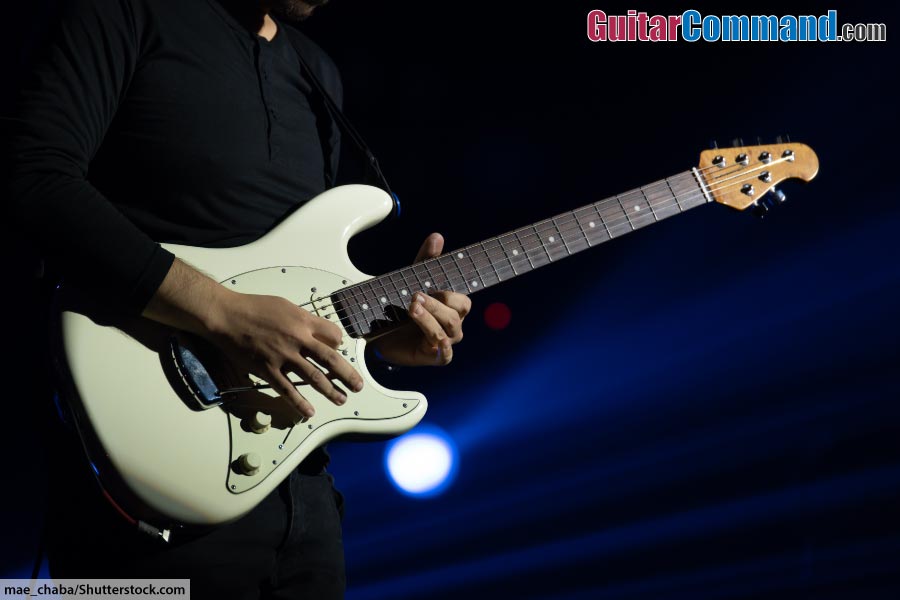
You can read about the different types of electric guitar on this page: Types Of Electric Guitars
Electric guitars rely on an amplifier to produce a usable sound – they emit only a very quiet, metallic sound when played acoustically.
Beginner guitarists usually find electric guitars easier to play than acoustic guitars. One of the main reasons for this is that the amount of finger pressure required to fret notes is usually substantially less on an electric.
The basic, or 'clean', sound of an electric guitar can be altered by electronic means. Guitar amplifiers usually have a multitude of knobs for adjusting the sound. In addition, guitarists often use effects pedals to alter the basic sound of the guitar.
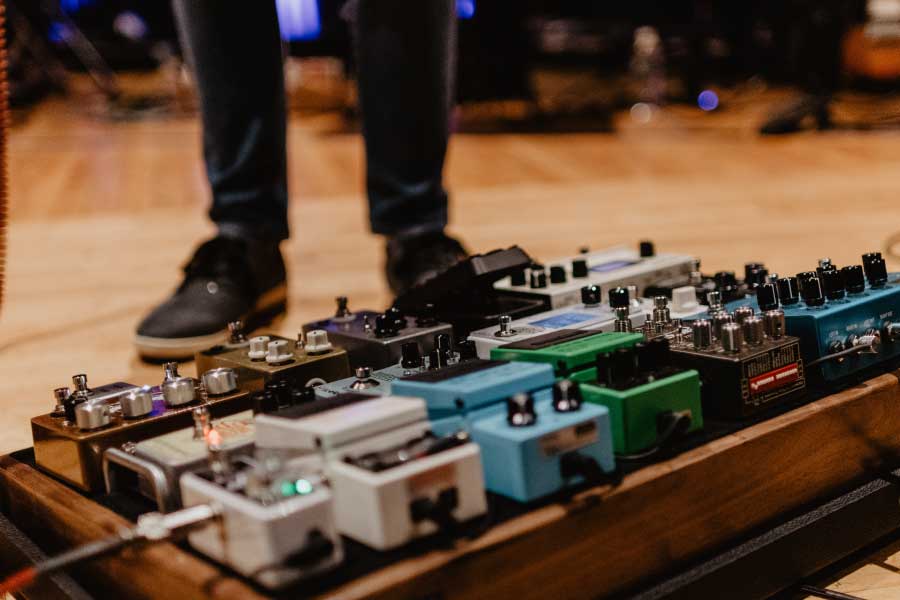
Some of the most common guitar effects are:
- Distortion: This effect saturates the guitar's signal, adding harmonic and inharmonic overtones. This results in a gritty, aggressive sound characteristic of rock and metal music. Distortion can vary from a slight, warm overdrive to a heavy, saturated fuzz.
- Reverb: Reverb simulates the natural echoes that occur in different spaces, like rooms, halls, or cathedrals. This effect creates a sense of spatial depth and ambiance, making the guitar sound as if it's in a larger or more open space.
- Delay: Delay repeats the sound of the guitar at set intervals and volumes after the original note is played. It can be used to create a simple echo effect or more complex rhythmic patterns. Delays can vary in time, from very short slap-back echoes to longer, sustained repeats.
- Chorus: Chorus creates a shimmering, thickening effect by duplicating the original signal, slightly altering the timing and pitch of the duplicate, and then mixing it back in with the original. This results in a sound that seems to have multiple instruments playing the same part slightly out of sync, adding richness and depth.
Classical Guitar

Classical guitars (also called 'Spanish guitars') are strung with nylon strings (although the three lowest strings are wound with metal), which produce a softer, more mellow sound than the steel strings of an acoustic guitar.
Stringing a classical guitar with acoustic guitar strings can cause severe damage due to the increased tension, as classical guitars are not designed to withstand the higher stress of steel strings.
Classical guitars are used to play music by composers such as Bach, Sor and Albeniz. They are occasionally used in rock and pop, usually to add a Spanish sound to the music.
The technique required to play the classical guitar is more formal that required to play electric and acoustic guitars. There is more emphasis on reading music and less emphasis on improvisation.
You can find out more about playing classical guitar on this page: Learning Classical Guitar
Bass Guitar

Bass guitars have four strings, which are tuned: E, A, D, G (the same notes as the lowest four strings of a standard guitar, but tuned an octave lower).
Bass guitars generally provide the bass lines in rock, pop and jazz music. They can also be used to play lead lines and riffs.
You can read our complete beginner's guide to playing bass guitar on this page: Playing Bass Guitar
Find out more about the bass guitar on this page: Is a Bass a Guitar?
Guitar Basics - I'm Left-Handed; Should I Buy A Left-Handed Guitar?
Guitars are available in both standard and left-handed forms.
When playing a standard guitar, the left hand holds down the strings at the required position on the fretboard, while the right hand plucks or strums the strings.
On a left-handed guitar, the role of each hand is reversed.
You might think that the choice is clear-cut; buy a standard guitar if you're right-handed and a left-handed guitar if you're left handed.
But it's not quite that simple. Many left-handed people play standard guitars (including the writer of this article).
Because both hands are involved in playing the guitar, there's no real advantage in a left-handed person playing a left-handed guitar.
If you're left-handed, we suggest that you start with a standard guitar; most tuition books and videos are aimed at people who play standard guitars, and you'll have a much wider range of guitars to choose from.
If you really can't get to grips with a standard guitar, then change to a left-handed guitar.
Guitar Basics – Tuning
Before playing, a guitar's strings must be tuned to the correct pitches. Most guitars drift out of tune over time, and it's rare that you'll be able to take a guitar out of its case and begin playing without having to tune up first. (An out of tune guitar sounds terrible!)
Tuning a guitar string involves turning the relevant tuning peg to adjust the string's tension until it vibrates at the desired pitch.
The most common tuning for a standard six-string guitar is E-A-D-G-B-E, starting from the thickest string (lowest in pitch) to the thinnest string (highest in pitch). Other tunings are used, but the standard tuning is by far the most common.

You can either tune a guitar by ear using a reference pitch (e.g. from a piano or tuning fork), or you can tune using an electronic guitar tuner.
For beginners, we strongly recommend that you invest in an electronic tuner; not only will it save you hours of time, but also it will help accustomise your ears to the correct pitches of the strings.
If you don't have a reference instrument or tuner to hand, then you can tune a guitar so that its strings are in tune with each other (but not necessarily with other instruments). This is fine if you're playing by yourself.
Find out how to tune a guitar here: Standard Guitar Tuning.
Learn about the notes of the fretboard here: Guitar Strings Notes.
Playing Notes And Chords
When playing guitar, one hand (the fretting hand) holds down single notes or chords on the fretboard, while the other hand picks or strums the strings.
For a standard guitar, the left hand is the fretting hand and the right hand sounds the strings. When playing a left-handed guitar, the hands' roles are reversed.


Should I Play With A Pick Or With My Fingers?
A pick (also called a plectrum) is a small, rounded triangular piece of plastic that is used to pluck or strum the guitar strings. It is usually held between the thumb and index finger.
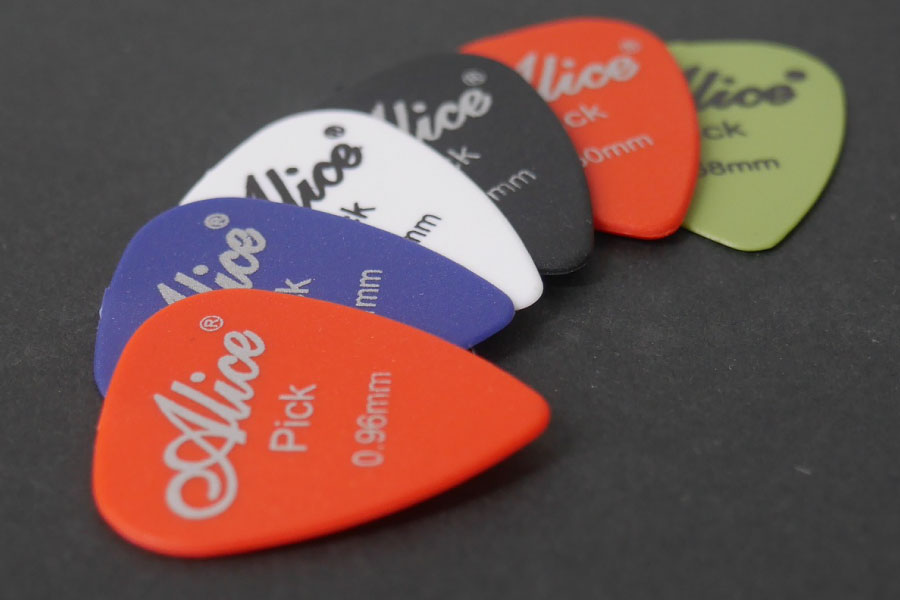

You can find out how to hold a pick on this page: how to hold a guitar pick.
Most electric guitarists, and many acoustic and bass guitarists use a pick when playing the guitar.
Nearly all classical guitarists, some acoustic guitarists and bass guitarists, and a small minority of electric guitarists play guitar with their fingers instead of a pick. This is known as "fingerstyle" or "fingerpicking".
- Playing with a pick produces a stronger, more defined sound, but limits the player to playing single notes or strumming chords.
- Fingerpicking produces a softer, more nuanced tone and offers more control over individual strings, allowing for intricate compositions with separate melody, bass, and harmony lines. However, it is harder (in general) to play fast lines using the fingers than with a pick.
Playing Guitar Chords
A chord is simply a group of notes played at the same time. There are many different types of chord, each with their own individual sound.
The three most common types of chord are: major, minor and dominant seventh. (Dominant seventh chords are also known simply as "seventh" or "seven" chords.)
Major chords typically sound happy; minor chords sad; and dominant chords expectant (although this is dependent on musical context.)
Chord symbols are typically used instead of the full names of chords. A chord symbol consists of the root note of the chord followed by the symbol for the type of chord to be played.
A capital letter with no symbol usually implies that a major chord should be played.
Examples Of Basic Guitar Chord Symbols:
C = C major
Cm = C minor,
C7 = C dominant seventh,
D = D major,
Dm = D minor,
D7 = D dominant 7th
Chord Boxes
Guitar chords are also often shown as chord boxes. Chord boxes are diagrams that represent the fretboard. They show where the fingers of the fretting hand should be positioned in order to play a particular chord.
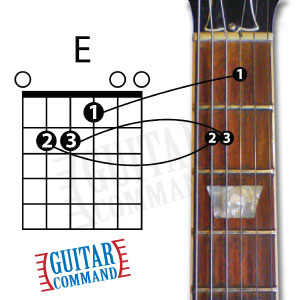
Strumming Chords
Strumming is a way of playing chords rhythmically in order to provide an accompaniment for other musicians or singers, and is an essential basic technique for most guitarists. Accompaniments to many famous songs can be played with as few as three chords.
Most guitarists use a pick to strum chords, although the fingers or thumb can be used for a different effect.
You can learn some basic strumming patterns here: Guitar Strumming Patterns.
Printable eBook containing virtually every guitar chord you'll ever need: Guitar Chord Book
Lead Guitar
Lead guitar usually means improvising a solo, although the term can also refer to playing the main part or riff in a song (rather than an accompanying part).
Playing a lead guitar solo gives a guitarist the chance to take the limelight for a few bars – either to express himself musically, or to show off how many notes he can play per second (or both!)
Lead guitar solos are usually built on scales such as the major scale, pentatonic scale or blues scale.
You can see all of the main guitar scales used by guitarists on this page: Guitar Scales
Riffs
Riffs are short musical phrases that are repeated at various parts of a song. They can also be used as introductions to songs, and as accompaniment parts. Riffs can be played by either the lead or rhythm guitarist, or both.
Guitar Music
Many guitarists get by without reading traditional musical notation. This is because: a) popular musicians often learn songs by ear; b) popular music is improvisatory in nature; and c) guitarists also have two other ways of reading music, namely chord charts and tablature (usually shortened to "tab").
Chord Charts
Chord charts show the guitarist which chords should be played and where.

TAB
TAB is a way of writing music for fretted instruments. It shows the fret number at which the fingers should be positioned. It is often printed underneath traditional musical notation.

You can find out more on how to read guitar tab on this page: What Is Guitar Tab?
Traditional music notation
Although traditional music notation can be used by all guitarists, only for classical guitarists is being able to read music considered to be an essential skill. (Classical guitar music is rarely printed with tab.) Guitar notation is written an octave higher than it is played.
Being able to read music allows a guitarist to communicate with other musicians. We recommend that you at least acquaint yourself with how traditional music notation works.
You can see where the notes are on the guitar fretboard on this page: Guitar Notes
Guitar Basics - Further Reading
How Long Does It Take To Learn Guitar
Guitar Basics - Conclusion
We hope that this page has been useful to you if you are thinking about learning the guitar. The guitar is a versatile and expressive instrument, and has the potential to provide you with years of enjoyment.
Because the basics are the same for all types of guitar, you can change between them depending on where you are in your musical career. Many classical guitarists started on electric or acoustic instruments, and vice versa.
We wish you many years of happy guitar playing!
Guitar Command is a dedicated publisher of music and tuition material for the guitar. Our high-quality Guitar Backing Tracks are used by thousands of guitarists all over the world.



Thank you for this useful information.
Good lessons, appreciate the site.
I’m new in the guitar its helphul For me. Than
ks